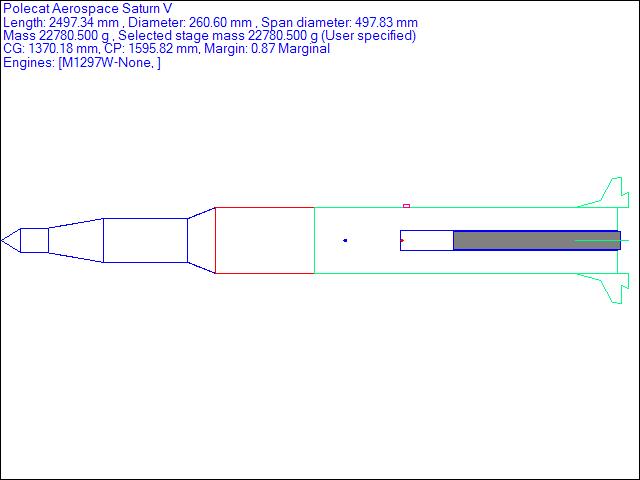
This portion of the document uses guestimated masses based upon the manufacturer's data. It will be revised as the build-up of the kit progresses.
The kit instructions are available for download from the manufacturer at http://www.polecataerospace.com/instructions/saturnv.pdf in Adobe Acrobat format.
This is a Rocksim model of the outside of the Polecat Saturn V rocket kit. No attempt was made to model the interior components. Different colors were used to denote the separation planes in the recovery system. This is an assumed mass based upon the manufacturer's report of typical finished weight. The CG was assigned to produce a CG, as specified by the manufacturer, five inches below the top of the lower airframe tube when fully loaded.
The recommended cert 3 motor is the AeroTech M1297W-P using the RMS-75/5120 casing classified as the M1297W-P by the TRA motor testing committee. Polecat Aerospace predicts an altitude of about 3000 feet using that motor.

This Rocksim model shows the model with an installed M1297 motor.
Polecat Aerospace recommends the 98mm Aeropack motor retainer and the Aeropack 75mm->98mm motor adaptor will be used.
Polecat Aerospace recommends the use of four #4 nylon screws for separation control of the main nosecone and the same for the payload bay. The holes will be strengthened with CA glue and the mating tube surfaces with a thin layer of epoxy.
Note that there is almost one caliber of stability.
The thrust to weight ratio is 5.8.
The Rocksim simulation reports that 45 ft/sec velocity is reached after 52" of travel. The Whitaker's Unistrut rail is ten feet in length. Polecat Aerospace suggests mounting the top rail button into the furthest forward motor mount ring. That is approximatly 33" from the base of the rocket. That rail button will leave the rail after the rocket has travelled 87" so the rocket will be travelling faster than 45 ft/sec when the top rail button leaves the rail channel. Unistrut rail buttons will be used and are expected to be mounted with 1/4" Tee-nuts.
Last revised 2005-09-28.
Back to Will's Cert 3 page.